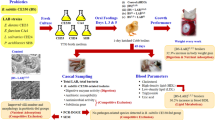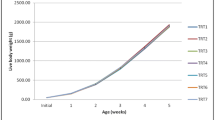Abstract
This study was conducted to examine effects of resistant starch (RS), compared to fructooligosaccharide (FOS) and zinc bacitracin (ZnB), on cecal short-chain fatty acids, cecal microflora intestinal morphology, and antibody titer against Newcastle disease virus in broilers. The experiment groups included the control group (basal diet with no additive; CON), four groups receiving different levels of RS type 2 (1, 2, 3, and 4% in basal diet; RS), a FOS group (0.4% of basal diet), and a ZnB group (50 mg/kg of basal diet). On day 35, the highest concentration of acetic, propionic, and butyric was found in the 4% RS, showing a significant difference from the CON as well as the FOS and the ZnB (P < 0.05). The greatest lactobacillus count was found the FOS (P < 0.05), and of the groups that received RS, the 4% RS had the greatest lactobacillus count. The smallest coliform count was found in the 3% and 4% RS groups (P < 0.05). In the duodenum and the jejunum, the largest villus height (VH) and the smallest crypt depth (CD) were found in the ZnB. Among the groups treated with RS, the 3% RS had the greatest VH and the smallest CD. The group that received FOS showed the greatest antibody titer on day 23, and of the groups treated with RS, the 4% RS had the greatest antibody titer showing a significant difference from the CON. The findings suggest that adding 3 and 4% RS or FOS to broiler’s feed may improve intestinal health.
Similar content being viewed by others
References
Adhikari PA, Kim WK (2017) Overview of prebiotics and probiotics: focus on performance, gut health and immunity–a review. Ann Anim Sci 17:949–966
Ashwar BA, Gani A, Shah A, Wani IA, Masoodi FA (2016) Preparation, health benefits and applications of resistant starch—a review. Starch-Stärke 68:287–301
Bhandari S, Nyachoti C, Krause D (2009) Raw potato starch in weaned pig diets and its influence on postweaning scours and the molecular microbial ecology of the digestive tract. J Anim Sci 87:984–993
Bird A, Conlon M, Christophersen C, Topping D (2010) Resistant starch, large bowel fermentation and a broader perspective of prebiotics and probiotics. Benefic Microbes 1:423–431
Catalá-Gregori P, García V, Madrid J, Orengo J, Hernández F (2007) Response of broilers to feeding low-calcium and total phosphorus wheat-soybean based diets plus phytase: performance, digestibility, mineral retention and tibiotarsus mineralization. Can J Anim Sci 87:563–569
Dibaji SM, Seidavi A, Asadpour L, Moreira da Silva F (2014) Effect of a synbiotic on the intestinal microflora of chickens. J Appl Poult Res 23:1–6
Dibner J, Richards J (2005) Antibiotic growth promoters in agriculture: history and mode of action. Poult Sci 84:634–643
Fuentes-Zaragoza E, Riquelme-Navarrete M, Sánchez-Zapata E, Pérez-Álvarez J (2010) Resistant starch as functional ingredient: a review. Food Res Int 43:931–942
Fuentes-Zaragoza E, Sánchez-Zapata E, Sendra E, Sayas E, Navarro C, Fernández-López J, Pérez-Alvarez JA (2011) Resistant starch as prebiotic: a review. Starch-Stärke 63:406–415
Gadde U, Kim W, Oh S, Lillehoj HS (2017) Alternatives to antibiotics for maximizing growth performance and feed efficiency in poultry: a review. Anim Health Res Rev 18:26–45
Geier M, Torok V, Allison G, Ophel-Keller K, Hughes R (2009) Indigestible carbohydrates alter the intestinal microbiota but do not influence the performance of broiler chickens. J Appl Microbiol 106:1540–1548
Hamer HM, Jonkers D, Venema K, Vanhoutvin S, Troost F, Brummer RJ (2008) The role of butyrate on colonic function. Aliment Pharmacol Ther 27:104–119
He X, Sun W, Ge T, Mu C, Zhu W (2017) An increase in corn resistant starch decreases protein fermentation and modulates gut microbiota during in vitro cultivation of pig large intestinal inocula. Anim Nutr 3:219–224
Jensen M, Cox R, Jensen BB (1995) Microbial production of skatole in the hind gut of pigs given different diets and its relation to skatole deposition in backfat. Anim Sci 61:293–304
Kawakami S, Han K-H, Araki T, Ohba K, Wakabayashi T, Shimada K, Fukushima M (2017) Potato powders prepared by successive cooking-process depending on resistant starch content affect the intestinal fermentation in rats. Biosci Biotechnol Biochem 81:359–364
Keenan MJ, Janes M, Robert J, Martin RJ, Raggio AM, McCutcheon KL, Pelkman C, Tulley R, Goita M'F, Durham HA, Zhou J, Senevirathne RN (2013) Resistant starch from high amylose maize (HAM-RS2) reduces body fat and increases gut bacteria in ovariectomized (OVX) rats. Obesity 21:981–984
Kleessen B, Stoof G, Proll J, Schmiedl D, Noack J, Blaut M (1997) Feeding resistant starch affects fecal and cecal microflora and short-chain fatty acids in rats. J Anim Sci 75:2453–2462
Lockyer S, Nugent A (2017) Health effects of resistant starch. Nutr Bull 42:10–41
Ma Z, Boye JI (2017) Research advances on structural characterization of resistant starch and its structure-physiological function relationship: a review. Crit Rev Food Sci Nutr 1–25
M'Sadeq SA, Wu S-B, Swick RA, Choct M (2015) Dietary acylated starch improves performance and gut health in necrotic enteritis challenged broilers. Poult Sci 94:2434–2444
Oakley BB, Lillehoj HS, Kogut MH, Kim WK, Maurer JJ, Pedroso A, Lee MD, Collett SR, Johnson TJ, Cox NA (2014) The chicken gastrointestinal microbiome. FEMS Microbiol Lett 360:100–112
Regassa A, Nyachoti CM (2018) Application of resistant starch in swine and poultry diets with particular reference to gut health and function. Anim Nutr 4:305–310
Ricke S (2015) Potential of fructooligosaccharide prebiotics in alternative and nonconventional poultry production systems. Poult Sci 94:1411–1418
Shen D, Bai H, Li Z, Yu Y, Zhang H, Chen L (2017) Positive effects of resistant starch supplementation on bowel function in healthy adults: a systematic review and meta-analysis of randomized controlled trials. Int J Food Sci Nutr 68:149–157
Suresh G, Das RK, Kaur Brar S, Rouissi T, Avalos Ramirez A, Chorfi Y, Godbout S (2018) Alternatives to antibiotics in poultry feed: molecular perspectives. Crit Rev Microbiol 44:318–335
Topping DL, Fukushima M, Bird AR (2003) Resistant starch as a prebiotic and synbiotic: state of the art. Proc Nutr Soc 62:171–176
Xu Z, Hu C, Xia M, Zhan X, Wang M (2003) Effects of dietary fructooligosaccharide on digestive enzyme activities, intestinal microflora and morphology of male broilers. Poult Sci 82:1030–1036
Zaman SA, Sarbini SR (2016) The potential of resistant starch as a prebiotic. Crit Rev Biotechnol 36:578–584
Zhou L, Fang L, Sun Y, Su Y, Zhu W (2017) Effects of a diet high in resistant starch on fermentation end-products of protein and mucin secretion in the colons of pigs. Starch-Stärke 68:1–7
Acknowledgements
The authors wish to acknowledge the assistance of Mr. Rashidi the CEO of Tehran Targol Pars, in supplying resistant starch. We are also thankful to Prof. Mingan Choct (University of New England) for his invaluable and helpful insight in conducting this study.
Author information
Authors and Affiliations
Corresponding author
Ethics declarations
Conflict of interest
The authors declare that they have no conflict of interest.
Ethical approval
All applicable international, national, and/or institutional guidelines for the care and use of animals were followed.
Additional information
Publisher’s note
Springer Nature remains neutral with regard to jurisdictional claims in published maps and institutional affiliations.
Rights and permissions
About this article
Cite this article
Akbaryan, M., Mahdavi, A., Jebelli-Javan, A. et al. A comparison of the effects of resistant starch, fructooligosaccharide, and zinc bacitracin on cecal short-chain fatty acids, cecal microflora, intestinal morphology, and antibody titer against Newcastle disease virus in broilers. Comp Clin Pathol 28, 661–667 (2019). https://doi.org/10.1007/s00580-019-02936-9
Received:
Accepted:
Published:
Issue Date:
DOI: https://doi.org/10.1007/s00580-019-02936-9




